International Journal of Modern Education and Computer Science @ijmecs
Статьи журнала - International Journal of Modern Education and Computer Science
Все статьи: 1123
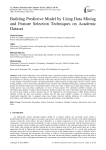
Building Predictive Model by Using Data Mining and Feature Selection Techniques on Academic Dataset
Статья научная
In the field of education, every institution stores a significant amount of data in digital form on the academic performance of students. If this data is correctly analysed to discover any pattern related to student learning, it can assist the institution in achieving a favorable outcome in the future. Because of this, the use of data mining techniques makes it much simpler to unearth previously concealed information or detect patterns in student data. We use a variety of data mining methods, such as Naive Bayes, Random Forest, Decision Tree, Multilayer Perceptron, and Decision Table, to predict the academic performance of individual students. In the real world, a dataset may contain many features, yet the mining process may only place significance on some of those aspects. The correlation attribute evaluator, the information gain attribute evaluator, and the gain ratio attribute evaluator are some of the feature selection methods that are used in data mining to remove features that are not important for the mining process. Other feature selection methods include the gain ratio attribute evaluator and the gain ratio attribute evaluator. In conclusion, each classification algorithm that is designed using some feature selection methods enhances the overall predictive performance of the algorithms, which in turn improves the performance of the algorithms overall.
Бесплатно
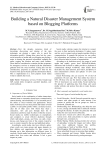
Building a Natural Disaster Management System based on Blogging Platforms
Статья научная
Over the decades, numerous kinds of knowledge discovering and sharing of the data techniques are playing a major role to reach the information quickly. Among these since last few years, social networks or media and own blogging are playing a major in sharing the personal information, updating the status, tagging the location and many more features. These data are considered to examine and the acceptance for emergency services to respond with the information gathered from the social network. Taking this into the consideration, proposed an algorithm to find out the location of the person based upon the information shared. This is implemented on a most popular social media twitter to identify the tweets.
Бесплатно
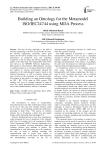
Building an Ontology for the Metamodel ISO/IEC24744 using MDA Process
Статья научная
The idea of using ontologies in the field of software engineering is not new. For more than 10 years, the Software Engineering community arouse great interest for this tool of semantic web, so to improve; their performance in production time and realisation complexity on the one hand, and software reliability and quality on the other hand. The standard ISO / IEC 24744, also known as the SEMDM (Software Engineering – Meta-model for Development Methodologies), provides in a global perspective, a conceptual framework to define any method of software development, through the integration of all methodological aspects related to the followed procedures, as well as, products, people and tools involved in the conception of a software product. The purpose of this article is to create domain ontology for ISO / IEC 24744 using an MDA process. This ontology will serve as semantic reference in order to assist for a better interoperability between the different users of the standard (human, software or machine).
Бесплатно
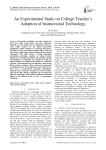
CHex: An Efficient RDF Storage and Indexing Scheme for Column-Oriented Databases
Статья научная
As increasingly large RDF data sets are being published on the Web, effcient RDF data management has become an essential factor in realizing the Semantic Web vision. However, most existing RDF storage schemes, which are built on top of row-store relational databases, are constrained in terms of efficiency and scalability. Still, the growing popularity of the RDF format used in real-world applications arguably calls for an effort to deal with these drawbacks. In this paper, we propose a novel RDF storage and indexing scheme, called CHex, which uses the triple nature of RDF as an asset to implement sextuple indexing for a column-oriented database system. Using binary association tables (BATs) in the column-oriented data model, RDF data is indexed in six possible ways, one for each possible ordering of the three RDF elements. The sextuple indexing scheme in a column-oriented database not only provides efficient single triple pattern lookups, but also allows fast merge-joins for any pair of two triple patterns. To evaluate the performance of our approach, we generate large-scale data sets upto 13 million triples, and devise benchmark queries that cover important RDF join patterns. The experimental results show that our approach outperforms the row-oriented database systems by upto an order of magnitude and is even competitive to the best state-of-the-art native RDF store.
Бесплатно
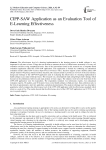
CIPP-SAW Application as an Evaluation Tool of E-Learning Effectiveness
Статья научная
The effectiveness level of e-learning implementation in the learning process at health colleges is very important for all users to know. Things that can be done to measure the level of effectiveness accurately is to carry out evaluation activities using computerized tools. One of the innovations found in this research was a computer-based evaluation application called the CIPP-SAW application. This application is formed by combining an educational evaluation model called CIPP (Context-Input-Process-Product) with a decision support system method called SAW (Simple Additive Weighting). Based on those situations, this research aimed to provide an overview of the user interface design and workings of the CIPP-SAW application used in evaluating the effectiveness of e-learning implemented in health colleges (case study in Bali province). This research was a development study using Borg & Gall’s design, which focused on the preliminary field test and main product revision stages. The subjects involved in the field trial of the CIPP-SAW application were 64 respondents. The respondents included: two informatics experts, two educational evaluation experts, 30 students, and 30 lecturers from several health colleges in Bali province. Data collection tools in the form of questionnaires, interview guidelines, and photo documentation. The analysis technique used was descriptive quantitative which compares the effectiveness level of the CIPP-SAW application with the effectiveness standard which refers to a scale of five. The results showed that the effectiveness level of the CIPP-SAW application was 87.521%, so it was in a good category.
Бесплатно
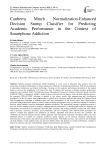
Статья научная
Student academic performance (SAP) prediction is a key issue in education data analysis. Also, the assessment of students’ performance is used to enhance the efficiency of educational institutions. With the development in educational institutions and modern technology, focusing on the academic performance prediction of the student based on access to the smartphone is the need of the hour. To improve the accuracy of student academic performance prediction, the Canberra Match Normalization-based Generalized Canonical Correlative Decision Stump Classifier (CMN-GCCDSC) is introduced. Initially, student data are collected from the dataset. After the data collection process, the proposed CMN-GCCDSC technique is applied in two phases namely data preprocessing and classification respectively. In the first phase, data preprocessing is carried out to eliminate duplicate data using the Canberra Match Data Normalization technique to minimize space and time consumption. In the second phase, data classification is performed with preprocessed output to classify student academic performance using a generalized canonical correlative decision stump classifier based on Smartphone addiction prediction. The generalized canonical correlation analysis is used for decision-making. Based on analysis, student academic performance is classified and results are obtained. An experimental assessment of the proposed CMN-GCCDSC technique and existing methods is carried out with metrics such as accuracy, sensitivity, specificity, space complexity, and time complexity. The CMN-GCCDSC technique is an effective solution that addresses the limitations of Genetic Algorithm (GA)-based decision tree classifiers. By combining the Decision Stump Classifier (DSC) approach with Generalized Canonical Correlation (GCC), the most important feature to consider for academic prediction among students can be selected, ultimately reducing the dimensionality of the dataset, and improving classifier performance. With higher accuracy rates achieved, this technique can help identify at-risk students early and discover hidden trends and patterns in student performance, leading to improved academic outcomes with additional support from institutions and faculties.
Бесплатно
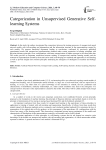
Categorization in Unsupervised Generative Self-learning Systems
Статья научная
In this study the authors investigated the connections between the training processes of unsupervised neural network models with self-encoding and regeneration and the information structure in the representations created by such models. We propose theoretical arguments leading to conclusions, confirmed by previously published experimental results that unsupervised representations obtained under certain constraints in training compliant with Bayesian inference principle, favor configurations with better categorization of hidden concepts in the observable data. The results provide an important connection between training of unsupervised machine learning models and the structure of representations created by them and can be used in developing new methods and approaches in self-learning as well as provide insights into common principles underlying the emergence of intelligence in machine and biologic systems.
Бесплатно
Статья научная
Application of Education Management Information System for administering school academic activities is widely recognized as an essential tool of improving quality of education for sustainable development. However, in developing countries including Tanzania, most secondary schools use manual system for collecting, storing and disseminating education information. The Manual system limits schools to have accurately, timely and reliable dissemination of education information. Moreover, when parents want to monitor student’s academic progress, the manual system requires them to visit schools physically and sometimes to wait until the end of the terminal and annual examination to get student academic report. Social and economic activities are one of the factors which limit parents to monitor student’s academic progress effectively. Poor parental involvement for monitoring and tracking student’s academic progress leads to poor student academic achievement. To address the solution, the study used structured interview and questionnaires to collect data from secondary schools education stakeholder. The collected data was analyzed using Pandas Python data analysis package. Findings from the study revealed that, poor student academic achievement in Tanzanian secondary schools is being caused by poor parental involvement in monitoring and tracking student’s academic progress. However, the study developed and implemented a centralized Education Management Information System for enhancing parental involvement in monitoring and tracking student’s academic progress. The significance of this study was to enhance parental involvement for student academic achievement by improving delivery of quality education for sustainable development.
Бесплатно
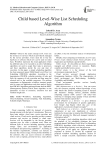
Child based Level-Wise List Scheduling Algorithm
Статья научная
Cloud is the Latest concept in IT. Users use the resources or services which are provided & managed by the service providers. Users need not to buy the hardware or software which now can be used on rental basis. Workflow represents the cloud application which has different tasks to be executed in an order. Scheduling algorithms are used to assign these tasks to processors and these algorithms decide the cost and time of execution. In this paper, a simple scheduling algorithm has been proposed named Child Based Level-Wise List Scheduling (CBLWLS) algorithm. According to the dependencies CBLWSL calculate priorities of tasks and finds the sequence of task execution and then maps the selected task to the available processors. We perform experiments on Epigenomics workflow structure graphs used in some real applications and their analysis shows that CBLWLS algorithm performed better than the HEFT (Heterogeneous Earliest Finish Time) algorithm, on the parameters of time of execution, execution cost and schedule length ratio.
Бесплатно
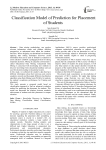
Classification Model of Prediction for Placement of Students
Статья научная
Data mining methodology can analyze relevant information results and produce different perspectives to understand more about the students’ activities. When designing an educational environment, applying data mining techniques discovers useful information that can be used in formative evaluation to assist educators establish a pedagogical basis for taking important decisions. Mining in education environment is called Educational Data Mining. Educational Data Mining is concerned with developing new methods to discover knowledge from educational database and can used for decision making in educational system. In this study, we collected the student’s data that have different information about their previous and current academics records and then apply different classification algorithm using Data Mining tools (WEKA) for analysis the student’s academics performance for Training and placement. This study presents a proposed model based on classification approach to find an enhanced evaluation method for predicting the placement for students. This model can determine the relations between academic achievement of students and their placement in campus selection.
Бесплатно
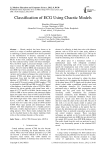
Classification of ECG Using Chaotic Models
Статья научная
Chaotic analysis has been shown to be useful in a variety of medical applications, particularly in cardiology. Chaotic parameters have shown potential in the identification of diseases, especially in the analysis of biomedical signals like electrocardiogram (ECG). In this work, underlying chaos in ECG signals has been analyzed using various non-linear techniques. First, the ECG signal is processed through a series of steps to extract the QRS complex. From this extracted feature, bit-to-bit interval (BBI) and instantaneous heart rate (IHR) have been calculated. Then some nonlinear parameters like standard deviation, and coefficient of variation and nonlinear techniques like central tendency measure (CTM), and phase space portrait have been determined from both the BBI and IHR. Standard database of MIT-BIH is used as the reference data where each ECG record contains 650000 samples. CTM is calculated for both BBI and IHR for each ECG record of the database. A much higher value of CTM for IHR is observed for eleven patients with normal beats with a mean of 0.7737 and SD of 0.0946. On the contrary, the CTM for IHR of eleven patients with abnormal rhythm shows low value with a mean of 0.0833 and SD 0.0748. CTM for BBI of the same eleven normal rhythm records also shows high values with a mean of 0.6172 and SD 0.1472. CTM for BBI of eleven abnormal rhythm records show low values with a mean of 0.0478 and SD 0.0308. Phase space portrait also demonstrates visible attractor with little dispersion for a healthy person’s ECG and a widely dispersed plot in 2-D plane for the ailing person’s ECG. These results indicate that ECG can be classified based on this chaotic modeling which works on the nonlinear dynamics of the system.
Бесплатно
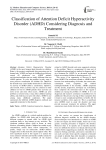
Статья научная
Attention Deficit Hyperactivity Disorder (ADHD) is the most frequent brain disorders in children. Brain is the greatest complicated data processing part in human body. ADHD can begin in childhood age and may extend till adolescent too. ADHD patients activities/actions/behaviour are totally different from non ADHD patients. To solve the problem in early stage is more precious contribution for children life. Otherwise the disorder may cause further destruction in child brain. An activity of ADHD child is: carelessness, impulsive, and feverish. These activities may be common in other children too but for ADHD patients these activities are more severe and more often occurs. ADHD can arise problems at school, home, it may affect children learning ability, and child may not join with others. ADHD is one among many childhood syndromes. The paper summarises the different ADHD diagnosis methods and suggested treatments for the disorder.
Бесплатно
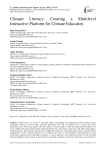
Climate Literacy: Creating a Multilevel Interactive Platform for Climate Education
Статья научная
Climate literacy is crucial to increasing public understanding and engagement with the global climate catastrophe. However, current climate education approaches often fail to effectively raise concern and action, particularly across diverse age groups. This study makes a modest attempt to detail the design and development of a novel multilevel interactive digital climate education platform for early learners, adolescents, and adults using adaptive learning pathways, personalized content delivery, multimedia interactivity, and gamification features to promote learner engagement as well as learning outcomes across different age levels. A mixed-methods research design was used involving pre and post-survey quantitative measures as well as qualitative user experience testing. Post-survey results indicated significant improvement in climate literacy knowledge, attitudes towards the environment, and self-efficacy beliefs regarding individual efforts to mitigate future climate impacts (response efficacy), regardless of learner age group. The comparative analysis thus revealed certain content preferences by age as well as interaction patterns among functionalities and learning gains between groups based on user perspectives that point towards differentiated preference areas linked with diverse ages. The resulting platform exemplifies interactive digital technologies’ potential for achieving sustainable behavior change through optimised synergies with large-scale educational interventions for inducing positive spillover effects in terms of broader widespread climate change engagement impact over generational transition pragma.
Бесплатно
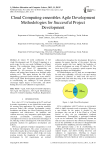
Cloud Computing ensembles Agile Development Methodologies for Successful Project Development
Статья научная
In today's IT world combination of AD (Agile Development) and CC (Cloud Computing) is a good recipe for the user needs fulfillment in efficient manners. This combination brings superiority for both worlds, Agile and Cloud. CC opportunities are optimized by AD processes for iterative software releases and getting more frequent user feedback while reducing cost. This paper analyzes the AM (Agile Methodology) processes and its benefits, issues with CC. ACD (Agile Cloud Development) approach helps a lot in overwhelming the challenges of both practices, encourages higher degree of innovation, and allows finding discovery and validation in requirements.
Бесплатно
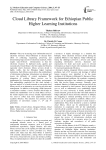
Cloud Library Framework for Ethiopian Public Higher Learning Institutions
Статья научная
The ever increasing users' information need of electronic resources forced librarians to increase their effort of collecting, organizing, preserving and disseminating huge amount of electronic materials, which require state-of-the-art infrastructures so that the electronic resources be deployed easily, quickly and economically. Cloud library is the best option for libraries; especially where electronic library services divide is highly visible, like the Ethiopian higher learning institutions. Such library system allows the establishment of information technology infrastructure on demand and lowers the difficulty of control mechanism. The integration of existing library services can be implemented by clustering current library environment. The methodology employed for this work include a rigorous analysis of a recent research on one point cloud library service as an alternative to e-service provision and management. In addition, to designing a final framework a researchers conduct a survey research which helps to identify the stakeholders view on cloud library services, the model required and services needed. Questionnaire was used to collect data from purposively selected academic libraries. The selection was centered on the generation of universities namely 1st, 2nd and 3rd generation.
Бесплатно
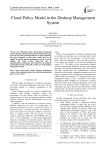
Cloud Policy Model in the Desktop Management System
Статья научная
By studying the policy and desktop management systems theories, referencing the Internet Engineering Task Force (IETF) policy model and theories of cloud computing, this paper proposed a cloud policy model that can be applied in specific desktop management system. It mainly explains the whole system framework and its implementation mechanisms, and it discusses the problems and solutions that the cloud policy model uses in the desktop management system.
Бесплатно
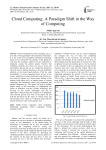
Cloud computing: a paradigm shift in the way of computing
Статья научная
Cloud computing has been emerging out as a new and evolving paradigm with tremendous momentum. It is one of the most acceptable information technology based service which drew the attention of the people not only from the academia, industry but also registered its popularity among the general people. Features like scalability, elasticity, less entry cost, easy to access and subscription and pay per use etc. compel the businesses and end users to migrate themselves from the traditional platform to the cloud based platform. With the wide acceptability of cloud computing based services in the society, people have various myths like some think it as a new name of internet, as it shares many features of the internet while others feel it as another name of existing technology like distributed system, grid computing, and parallel computing etc.. This paper will help in making people aware of this technology by highlighting the points of difference with the existing technology and focusing on the various advantages and area of application which presents the evidence of its popularity and continual growth. The work in the paper will end with the discussion on the status of various issues and shortcomings from which it is suffering along with the present and future scope in this popular area.
Бесплатно
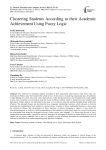
Clustering Students According to their Academic Achievement Using Fuzzy Logic
Статья научная
The software for clustering students according to their educational achievements using fuzzy logic was developed in Python using the Google Colab cloud service. In the process of analyzing educational data, the problems of Data Mining are solved, since only some characteristics of the educational process are obtained from a large sample of data. Data clustering was performed using the classic K-Means method, which is characterized by simplicity and high speed. Cluster analysis was performed in the space of two features using the machine learning library scikit-learn (Python). The obtained clusters are described by fuzzy triangular membership functions, which allowed to correctly determine the membership of each student to a certain cluster. Creation of fuzzy membership functions is done using the scikit-fuzzy library. The development of fuzzy functions of objects belonging to clusters is also useful for educational purposes, as it allows a better understanding of the principles of using fuzzy logic. As a result of processing test educational data using the developed software, correct results were obtained. It is shown that the use of fuzzy membership functions makes it possible to correctly determine the belonging of students to certain clusters, even if such clusters are not clearly separated. Due to this, it is possible to more accurately determine the recommended level of difficulty of tasks for each student, depending on his previous evaluations.
Бесплатно
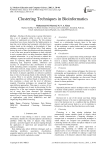
Clustering Techniques in Bioinformatics
Статья научная
Dealing with data means to group information into a set of categories either in order to learn new artifacts or understand new domains. For this purpose researchers have always looked for the hidden patterns in data that can be defined and compared with other known notions based on the similarity or dissimilarity of their attributes according to well-defined rules. Data mining, having the tools of data classification and data clustering, is one of the most powerful techniques to deal with data in such a manner that it can help researchers identify the required information. As a step forward to address this challenge, experts have utilized clustering techniques as a mean of exploring hidden structure and patterns in underlying data. Improved stability, robustness and accuracy of unsupervised data classification in many fields including pattern recognition, machine learning, information retrieval, image analysis and bioinformatics, clustering has proven itself as a reliable tool. To identify the clusters in datasets algorithm are utilized to partition data set into several groups based on the similarity within a group. There is no specific clustering algorithm, but various algorithms are utilized based on domain of data that constitutes a cluster and the level of efficiency required. Clustering techniques are categorized based upon different approaches. This paper is a survey of few clustering techniques out of many in data mining. For the purpose five of the most common clustering techniques out of many have been discussed. The clustering techniques which have been surveyed are: K-medoids, K-means, Fuzzy C-means, Density-Based Spatial Clustering of Applications with Noise (DBSCAN) and Self-Organizing Map (SOM) clustering.
Бесплатно
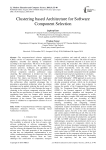
Clustering based architecture for software component selection
Статья научная
The component-based software engineering (CBSE) consists of component selection, qualification, adaptation, assembly and updating of components according to the requirements. The focus of this paper is software component selection only. Now-a-days many selection processes, techniques and algorithms are proposed for this task. This paper presents generalized software component selection architecture using clustering. The architecture is divided into four tiers namely Component Requirements and Component Selection Tier, Query and Decision Tier, Application logic tier with Clustering and Component Cluster Tier. The architecture offers manifold advantages like i) presenting a generalized architecture where the existing techniques can be applied, reducing the search space for the component selection. ii) It also illustrates the usage of clustering in the software component selection without the need for pre- specification of number of clusters and considering more than two features while clustering. iii)The cluster validation is performed to check the correctness of the clusters. This complete selection process is validated on a representative instance of set of components.
Бесплатно

